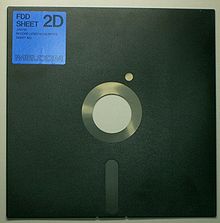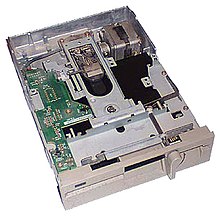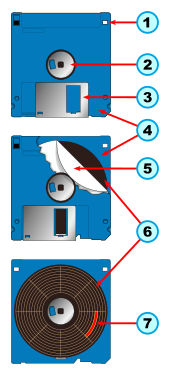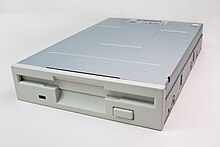Sizes[edit]
Main articles:
Floppy disk format and
List of floppy disk formats
Different sizes of floppy disks are mechanically incompatible, and disks can fit only one size of drive. Drive assemblies with both 3½-inch and 5¼-inch slots were available during the transition period between the sizes, but they contained two separate drive mechanisms. In addition, there are many subtle, usually software-driven incompatibilities between the two. 5¼-inch disks formatted for use with Apple II computers would be unreadable and treated as unformatted on a Commodore. As
computer platforms began to form, attempts were made at interchangeability. For example, the "
Superdrive" included from the
Macintosh SE to the
Power Macintosh G3 could read, write and format IBM PC format 3½-inch disks, but few IBM-compatible computers had drives that did the reverse. 8-inch, 5¼-inch and 3½-inch drives were manufactured in a variety of sizes, most to fit standardized
drive bays. Alongside the common disk sizes were
non-classical sizes for specialized systems.
8-inch floppy disk[edit]

8-inch floppy disk
The first floppy disk was 8 inches in diameter,
[1] was protected by a flexible plastic jacket and was a read-only device used by IBM as a way of loading microcode.
[22] Read/Write floppy disks and their drives became available in 1972 but it was IBM's 1973 introduction of the 3740 data entry system
[23] that began the establishment of floppy disks, called by IBM the "
Diskette 1," as an industry standard for information interchange. Early
microcomputers used for engineering, business, or word processing often used one or more 8-inch disk drives for removable storage; the
CP/M operating system was developed for microcomputers with 8-inch drives.
The family of 8-inch disks and drives increased over time and later versions could store up to 1.2 MB;
[24] many microcomputer applications did not need that much capacity on one disk, so a smaller size disk with lower-cost media and drives was feasible. The 5¼-inch drive succeeded the 8-inch size in many applications, and developed to about the same storage capacity as the original 8-inch size, using higher-density media and recording techniques.
5¼-inch floppy disk[edit]

Uncovered 5¼‑inch disk mechanism with disk inserted. The edge of the disk with the opening for the medium was inserted first, then the lever was turned to close the mechanism and engage the drive motor and heads.
The head gap of an 80‑track high-density (1.2 MB in the
MFM format) 5¼‑inch drive (a.k.a.
Mini diskette,
Mini disk, or
Minifloppy) is smaller than that of a 40‑track double-density (360 KB) drive but can format, read and write 40‑track disks well provided the controller supports double stepping or has a switch to do such a process. A blank 40‑track disk formatted and written on an 80‑track drive can be taken to its native drive without problems, and a disk formatted on a 40‑track drive can be used on an 80‑track drive. Disks written on a 40‑track drive and then updated on an 80 track drive become unreadable on any 40‑track drives due to track width incompatibility.
Single sided disks were coated on both sides, despite the availability of more expensive double sided disks. The reason usually given for the higher cost was that double sided disks were certified error-free on both sides of the media. Double-sided disks could be used in some drives for single-sided disks, as long as an index signal was not needed. This was done one side at a time, by turning them over (
flippy disks); more expensive dual-head drives which could read both sides without turning over were later produced, and eventually became used universally.
3½-inch floppy disk[edit]

Internal parts of a 3½‑inch floppy disk.
1) A hole that indicates a high-capacity disk.
2) The hub that engages with the drive motor.
3) A shutter that protects the surface when removed from the drive.
4) The plastic housing.
5) A polyester sheet reducing friction against the disk media as it rotates within the housing.
6) The magnetic coated plastic disk.
7) A schematic representation of one sector of data on the disk; the tracks and sectors are not visible on actual disks.
8) The
write protection tab (unlabeled) is upper left.

A 3½-inch floppy disk drive.
In the early 1980s, a number of manufacturers introduced smaller floppy drives and media in various formats. A consortium of 21 companies eventually settled on a 3½-inch floppy disk (actually 90 mm wide) a.k.a.
Micro diskette,
Micro disk, or
Micro floppy, similar to a
Sonydesign, but improved to support both single-sided and double-sided media, with formatted capacities generally of 360 KB and 720 KB respectively. Single-sided drives shipped in 1983,
[25] and double sided in 1984. What became the most common format, the double-sided, high-density (HD) 1.44 MB disk drive, shipped in 1986.
The first
Macintosh computers used single-sided 3½-inch floppy disks, but with 400 KB formatted capacity. These were followed in 1986 by double-sided 800 KB floppies. The higher capacity was achieved at the same recording density by varying the disk rotation speed with head position so that the linear speed of the disk was closer to constant. Later Macs could also read and write 1.44 MB HD disks in PC format with fixed rotation speed.
All 3½-inch disks have a rectangular hole in one corner which, if obstructed, write-enabled the disk. A sliding detented piece can be moved to block or reveal the part of the rectangular hole that is sensed by the drive. The HD 1.44 MB disks have a second, unobstructed hole in the opposite corner which identifies them as being of that capacity.
In IBM-compatible PCs, the three densities of 3½-inch floppy disks are backwards-compatible: higher density drives can read, write and format lower density media. It is physically possible to format a disk at the wrong density, although the resulting disk will not work properly. Fresh disks manufactured as high density can theoretically be formatted at double density only if no information has been written on the disk in high density, or the disk has been thoroughly demagnetized with a bulk eraser, as the magnetic strength of a high density record is stronger and overrides lower density, remaining on the disk and causing problems.
Writing at different densities than disks were intended for, sometimes by altering or drilling holes, was possible but deprecated. The holes on the right side of a 3½‑inch disk can be altered as to make some
disk drives and
operating systems treat the disk as one of higher or lower density, for bidirectional compatibility or economical reasons.[
clarification needed]
[26][27] Some computers, such as the
PS/2 and
Acorn Archimedes, ignored these holes altogether.
[28]
It is possible to make a 3½-inch floppy disk drive be recognized by a system as a 5¼‑inch 360 KB or 1200 KB drive, and to read and write disks with the same number of tracks and sectors as those disks; this had some application in data exchange with obsolete
CP/M systems.[
ci







